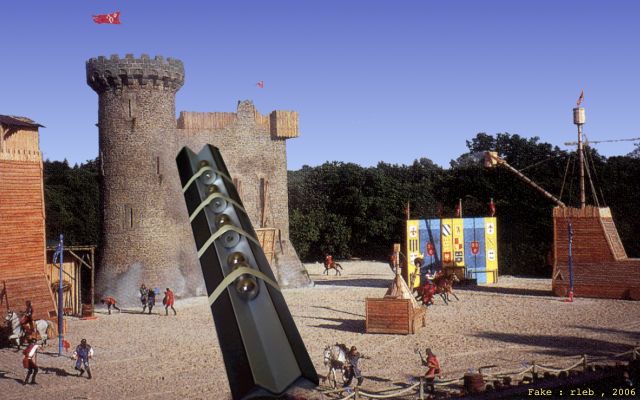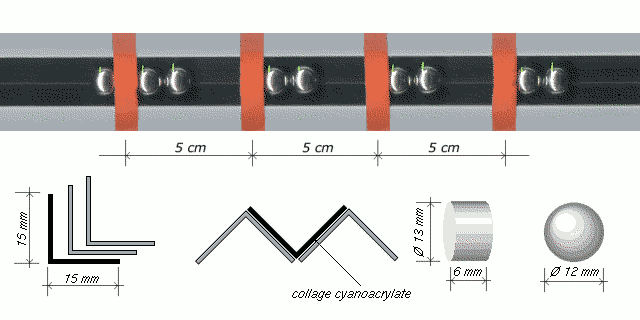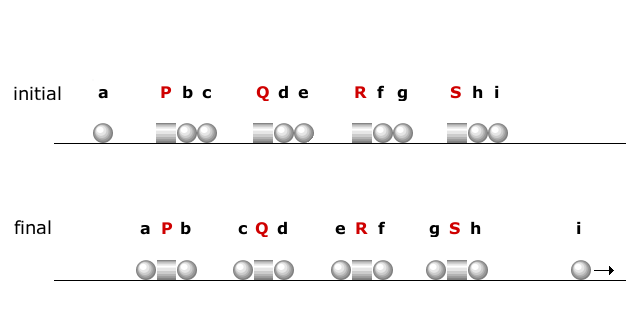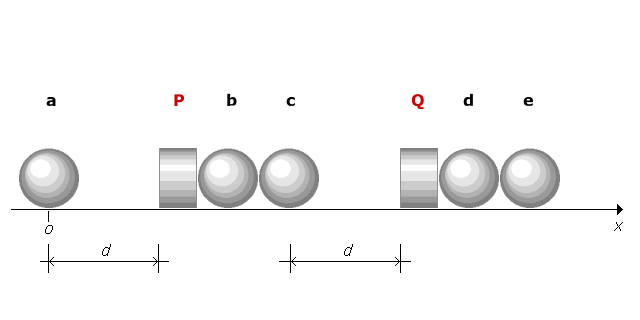| Mini museum | Electrostatics | µwave oven | Illusions | Visual geom. | Astro photo | Vision stereo | Links | Homepage |

|
A new war machine, the magnetic gun,
|
Last update |


In order to manage our project, we will have to get first the following parts:
- 4 magnets NdFeB diameter about 13 mm, lenght 6 mm
Conrad, part # 503659-55 - 9 steel balls diameter about 12 mm (about ½ inch), the model for ball bearings
Brammer - 1 ou 2 one meter length of angle PVC section, 15 mm width (3)
- some adhesive tape
- one dispenser of cyanoacrylic superglue
(For the last three items: any do-it-yourself shop)
Cut three lengths of PVC about 30 cm (12 iches) long, then assemble with superglue as shown on the figure above. If you got two colors of PVC then a mix does not hurt as related to aesthetics. Hold in position the four magnets by means of adhesive tape, spaced 5 cm (about 2 inches), then set in place the four groups of two balls.
Pour conduire ce projet il nous faut d'abord nous nous procurer les fournitures suivantes :
- 4 aimants NdFeB diamètre environ 13 mm, longueur 6 mm
Conrad, référence 503659-55 - 9 billes de roulement diamètre environ 12 mm
Brammer - 1 ou deux longueurs d'un mètre de corniè PVC de 15 mm (3)
- un peu de ruban adhésif
- un tube de colle cyanoacrylate
(Pour les trois derniers : n'importe quel magasin de bricolage)
Coupez 3 longueurs de cornière d'environ 30 cm, puis assembler par collage comme sur la figure ci-dessus. Si vous avez deux couleurs différentes de cornière, vous pouvez panacher, l'esthétique n'y perdra rien. Fixez alors les quatre aimants au moyen de ruban adhésif à intervalles de 5 cm, puis installez les quatre groupes de deux billes.

The balls are configured assez shown in the figure above (initial state), the ball a retained with a finger. Let the ball a to roll gently toward the magnet P. In a twinkling of an eye the configuration has changed (final state) and the ball i is escaping on the right with a great velocity.
Les billes sont disposées comme sur la figure ci-dessus (état initial), la bille a maintenue avec le doigt. Laissez la bille a rouler gentiment vers l'aimant P. En un clin d'oeil la configuration a changé (état final) et la bille i s'échappe vers la droite avec une grande vitesse.

What has happened ?
Each ball at rest at a distance d from a magnet has a potential energy
Wp = M x a x d
M being the mass of the ball, a the acceleration resulting from the force field created by the magnet and d the distance from the center of the ball to the magnet. The balls in contact with a magnet have no pentential energy, they are said to be at level zero. When the ball a rolls toward the magnet P it transforms that potential energy into kinetic energy. Travelling the distance d it has aquired a velocity V , a kinetic energy
Wk = ½ x M x V 2
and a momentum
p = M x V
As a simplification we assume the impacts of a onto P and the followings are 100% elastic collisions and intervening in an unidimensional space. So, in the conformity to the laws of physics, potential energy and momentum are conserved and are integrally transferred to the ball c. The ball c is then launched with the kinetic energy and momentum it received from a, so a velocity V. Travelling the distance d, it generates the same kinetic energy and momentum it received and so it impacts the magnet Q with a velocity 2 x V.
The same process repeats itself at each stage, so the ball i will be lauched with a velocity 4 x V. As the energy is proportional to the square of the velocity it will be multiplied by 16, wich is not negligible. The extent of the destructions being proportional to the energy, to multiply the number of stages transforms rapidly this benign device into "a massive destruction weapon". So it is wise to limit the number of stages to 4, it would be only to do not shatter the magnets, wich are very brittle.
Que s'est-il passé ?
Chaque bille au repos, à la distance d d'un aimant recèle une énergie potentielle
Wp = M x a x d
M étant la masse de la bille, a l'accélération résultant du champ de force créé par l'aimant et d la distance du centre de la bille à l'aimant. Les billes en contact avec un aimant n'ont aucune énergie potentielle, on dit qu'elles sont au niveau zéro. Lorque la bille a roule vers l'aimant P elle transforme cette énergie potentielle en énergie cinétique. Parcourant la distance d elle a acquis une vitesse V , une énergie cinétique
Wk = ½ x M x V 2
et une quantité de mouvement
p = M x V
Par mesure de simplification nous admettons que l'impact de a sur P (et les suivants) résulte en un choc 100% élastique et intervenant dans un espace à une dimension. Ainsi, conformément aux lois de la physique, il y a conservation de l'énergie cinétique et de la quantitté de mouvement, lesquelles sont entièrement transmises à la bille c. La bille c décolle avec l'énergie et la quantité de mouvement reçues de a, donc une vitesse V . Parcourant la distance d. elle développe la même énergie et la même quantité de mouvement qu'elle a reçues et ainsi vient frapper l'aimant Q avec une vitesse 2 x V.
Il en est de même à chaque étage, ainsi la bille i sera propulsée avec une vitesse 4 x V. Comme l'énergie est proportionnelle au carré de la vitesse, elle sera multipliée par 16, ce qui n'est pas négligeable. L'étendue des destructions étant proportionnelle à l'énergie, multiplier le nombre d'étages transforme rapidement ce petit dispositif en "une arme de destruction massive". C'est la raison pour laquelle il est sage de se limiter à 4 , ne serait-ce que pour ne pas briser les aimants, lesquels sont très cassants.
|
|
Mini museum | Electrostatics | µwave oven | Illusions | Visual geom. | Astro photo | Vision stereo | Links | Homepage |
File: gauss.html, 2006-09-09 - Robert L.E. Billon - Last update: 2010-11-08